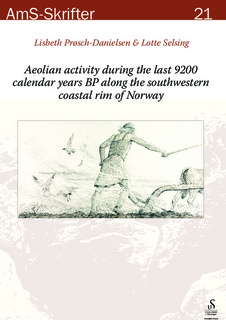| dc.description.abstract | Aeolian sand deposits intercalated with organic layers have been reported from Holocene sediment
sequences below the marine limit (ML) at twelve sites along the coastal rim of southwestern Norway for
over a century. This study, based on field investigations, stratigraphical analysis, radiocarbon dates and
archaeological information, has revealed several phases of aeolian activity. The premises and factors
permitting sand drift, as well as the timing of this activity, have been compiled and synthesised. The
premises for aeolian activity are the presence and supply of unconsolidated sandy sediments, wind
strong enough to transport sand particles and a sparse or absent vegetation cover. Sand drift is not
recorded along stretches of coast with numerous boulders. Aeolian activity is triggered by natural
factors, human impact or a combination of these. The oldest aeolian activities started about 8100 yrs BP
(9200 cal yrs BP) and were closely related to the Holocene sea-level displacement, while the youngest
activity is more tied to various kinds of human land use. Sand drift in Late Weichselian and Preboreal
times has not been recorded, perhaps partly because present-day sandy shores were submerged at that
time. The 7400 yrs BP (8200 cal yrs BP) cooling event corresponding to a period of Northern Atlantic
cooling is recorded by aeolian sand at only one site in this study. Sand drift is primarily located in areas
that were submerged during the Tapes transgression when the shoreline was located more than one
kilometre inland from the present coastline in parts of the area. Shallow fjords and estuaries were then
filled by sandy sediments transported by rivers, onshore waves and longshore drift. The Holocene Tapes
transgression was double-peaked which implies that the maximum high lasted for about 2000 calendar
years (6800-4800 yrs BP, 7640-5540 cal yrs BP). During the subsequent regression, the sandy sediments
were prone to erosion and sand drift. Aeolian activity is recorded continuously from about 6500 yrs BP
(7430 cal yrs BP) (the onset of the first Tapes regression), but obviously intensified during the second,
slow Tapes regression that started about 4800 yrs BP (5540 cal yrs BP). The way people have used the
land, at least since the Neolitisation of the area which started about 5200-4800 yrs BP (5950-5550 cal
yrs BP), first by forest clearance and pasturing, and later escalating through cultivation and heathland
management, has also increased sand drift. Sand drift correlates well with the metachronous forest
clearance steps 1-3 that started with the Neolitisation, and also with the two steps in the establishment
of Norwegian coastal heaths, both of which are recorded in the area investigated. Thus people were
important for altering climate, i.e. lower temperatures and stronger wind because of the deforestation.
Aeolian sand drift has also been tied to activity of Mesolithic people from about 6470 yrs BP (7380 cal
yrs BP), before agriculture was introduced. People probably influenced nature by burning and otherwise
managing vegetation. Medieval aeolian activity is documented from the “Little Ice Age” (AD 1350-
1850) and the Maunder Minimum (AD 1645-1715), the coldest phase of the “Little Ice Age”. | no_NO |
